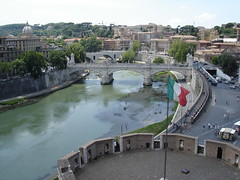 Rome (Photo credit: ryarwood)
Rome (Photo credit: ryarwood)By Simon Prendergast
When it comes to arranging the perfect study tour it's very important to make sure you pick the right location. There are plenty of destinations around the world that appeal to the travelling public in search of knowledge and experiences, but the eternal city of Rome is hard to beat. If you're lucky enough to be heading to this hotbed of history, then you might be interested in some of the lesser known sights and experiences on offer to visitors. Here is a brief rundown of some of the places you might think about including on your itinerary during your study tour to the 'Caput Mundi'.
The Keyhole
While it's not exactly a secret, the famous 'keyhole' fits the theme of secrecy. Curiously, one of the most intriguing sights in the whole of Rome is to be found by putting your eye up to a keyhole! If you take a trip to the top of the Aventine to visit the early Christian churches that occupy the top of the hill, make a point of stopping off at the Piazza dei Cavalieri di Malta. Here, visitors are encouraged to approach the large wooden door of the Priory to spy through the keyhole and enjoy one of the most surprising sights to be found on any study tour. Although text can't do justice to it, the view reveals a long chamber of trees covering a gravel path, focusing the viewers' gaze on the dome of St Peter's in the distance.
Porta Portese
This is one of the original city gates, built in 1644 as part of Pope Urban VIII's Janiculum Walls. If you happen to find yourself around the Porta Portese on a Sunday, then you'll be in the perfect place to enjoy one of the city's most popular flea markets. The market kicks off in the early morning but runs through until the afternoon. If your group are on the lookout for trinkets and idiosyncratic souvenirs, this is the best spot in the city for browsing watches, books, pottery and jewellery, and it also makes an excellent location for a spot of people-watching.
EUR
One of the more modern sites of interest for those heading to the Eternal city on an architectural study tour, the EUR is a far cry from the Coliseum and the Renaissance churches. The Esposizione Universale Roma was a projected new neighbourhood that was to reflect many references to the glory of Rome's past. The area was intended by Mussolini to be the site of the 1942 World's Fair, but the Second World War put paid to the plans. The buildings that remain today have become an important part of the commercial and residential landscape of the city, and are some of the finest examples of Fascist architecture that remain standing.
Simon Prendergast works for FHT, a company specialising in flexible and inspiring study tour options across a wide range of subjects. FHT's study tours benefit from over 40 years of experience arranging accommodation, educational itineraries, and everything leaders need to plan a successful trip.
Article Source: http://EzineArticles.com/?expert=Simon_Prendergast
http://EzineArticles.com/?The-Lesser-Seen-Side-of-Rome&id=7006742
E-Book
PrintBook
